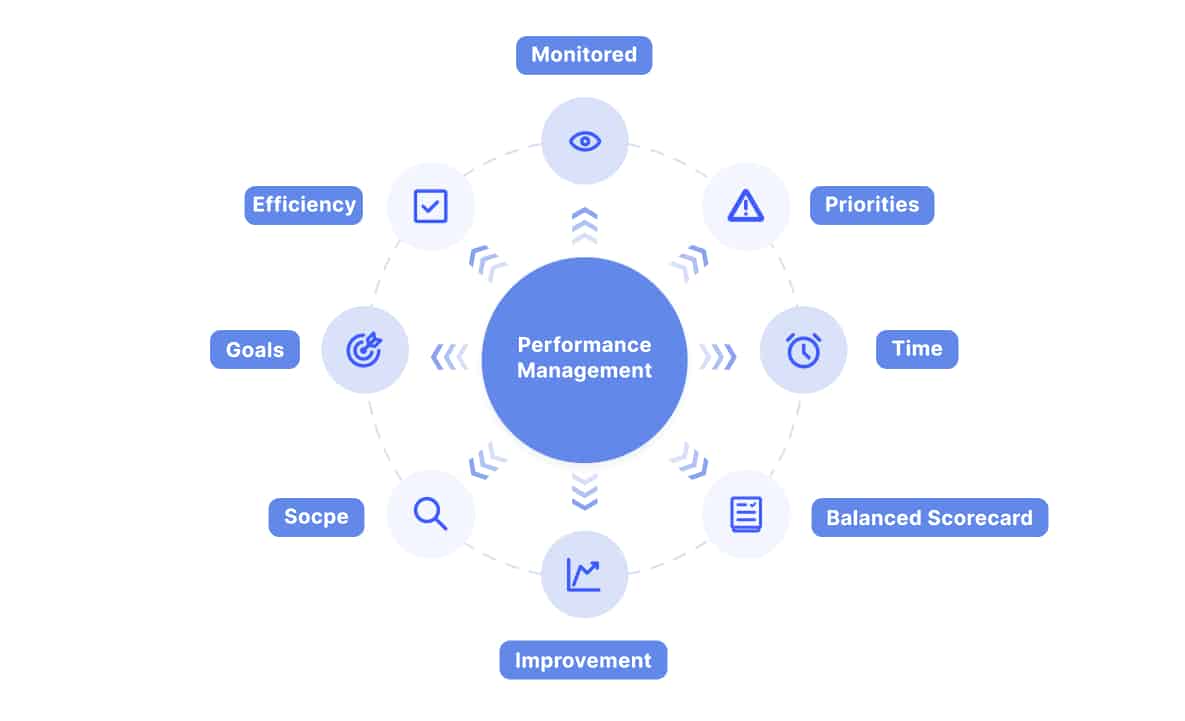ARTICLE SUMMARY
A guide

Reviewing an employee’s performance can be a daunting task. You must be able to illustrate how the employee’s work has impacted the company, and provide a sensible plan for their professional development. Above all, you’re expected to provide an experience that’s fair, helpful, and organized.
Even though most companies have some sort of performance review process in place, effectively evaluating performance is an art that many of us have yet to master. Most employees find the performance review process stressful and uncomfortable — only 14 percent of employees strongly agree that their reviews inspire them to improve.
One strategy that can make performance management easier for managers and employees is to improve the process itself. In this article, we’ll explore the performance management process, and consider some of the ways you can make it a positive, constructive experience for everyone involved.
What is performance management process?
The definition of performance management process is simple. It is an evaluation system that continuously aligns organizational objectives with employee competency, incentives, and development. In other words, it’s all about providing employees with ongoing, constructive feedback on how they’re doing and how they can improve to better support their own professional goals and the goals of their team and the company. The keyword here is “ongoing” — performance management isn’t a once-a-year process, it’s a continuous effort.
This is easier said than done. We are accustomed to performance evaluations in some form or another, usually via yearly reviews. Many organizations that track employee performance incentivize workers to achieve very specific business outcomes without bothering to help employees reach their own professional goals. As a result, employees become burned out and disengaged.
Thankfully, an increasing number of organizations are pivoting to comprehensive performance management, introducing employee learning opportunities, formalized feedback, mentoring or coaching sessions, and other ways for employees to advance their careers.

What to expect from a good performance management system
Creating a robust performance management process leads to significant benefits across your organization.
Better communication
Performance management systems create an infrastructure that naturally requires managers and employees to communicate on a consistent basis. This can lead to more candid conversations about how to improve certain skills, form stronger work relationships, and promote a greater understanding of a company’s objectives. When employees and their managers talk about performance-related issues more frequently, those conversations seem less scary and are more productive.
Clear expectations
Thanks to fostering better communication, performance management systems also create an environment where each team member knows what’s expected of them. Because of that clarity, employees can develop better goals for themselves and truly grasp where and how they fit into the company’s mission.
Steady improvement
Frequent check-ins with employees help them stay on the path to improvement. At companies with annual reviews, employees are often left to course-correct on their own, so it’s easy for bad habits to set in before their next review. The focus on steady improvement that stems from a strong performance management system helps keep workers on the path to achieving their goals.
An engaged workforce
Rather than spending an inordinate amount of time on annual reviews, performance management systems prompt managers and employees to take reviews into their own hands. With the right tools and software, businesses can set up automated reminders for various stages of the process, like scheduling review meetings or submitting comments and other relevant performance information. With everyone engaged, employees feel heard and managers can stay on top of offering more productive feedback.

Defining a performance management system that works
A performance management system helps businesses set expectations for their employees, rate them on their performance, and give them constructive feedback. However, the system needs certain components in order to be truly effective:
- Planning and goal-setting: Employees should set realistic goals so managers can deliver a review that accurately represents the worker’s skills and progress. One way to do this is to use the SMART method. This refers to goals that are specific, measurable, achievable, results-oriented, and time-bound. Employees and managers should collaborate to set objectives that incorporate all of these characteristics.
- Ongoing communication, observation and mentoring: Performance management should be an ongoing process, not just an annual review. Good managers regularly observe how their employees interact with others, approach difficult assignments, or deal with setbacks. They can then provide timely recognition or feedback instead of waiting for the yearly performance review, and employees can implement new behaviors earlier.
- Social recognition: People commonly think of rewards in the form of compensation or bonuses, but excellent managers realize the impact of non-monetary rewards, too. Whether it’s a shout-out in a group setting, a thank you card, or a brief email or chat message, social recognition makes employees feel seen and appreciated for their contributions. Managers should make it a habit to frequently recognize employees who are doing a great job.
- Feedback and suggestions: Workers can only improve if they know how to get better at their job. Finding ways for employees to sharpen their skills and step out of their comfort zone is part of a manager’s duties. Offering feedback or suggestions on how to get assigned certain projects or how to get promoted should be a major part of the performance management process.
Performance management process gone wrong
Anyone can fall into common performance management traps if they aren’t careful. To make sure this doesn’t happen, be on the lookout for these telltale red flags that can cut the legs out from under an otherwise effective performance management system.
Failing to accurately capture employees’ work
It is nearly impossible for managers to take stock of everything each of their employees has done in a full year. The same goes for employees regarding their own performance. Good performance management systems encourage employees to log their accomplishments more frequently. This regularly reminds employees of how much they’ve done and gives managers a better picture of their employees’ workloads throughout the year.
Going through the motions
Getting both managers and employees to buy into regularly evaluating performance can be difficult. It’s understandable — finding time to think seriously and more frequently about employees’ performance amidst so many competing priorities isn’t easy. So it’s important to make sure that managers who don’t have as much experience engaging in an ongoing performance management process understand the value of providing regular, actionable feedback and don’t view review sessions as just another task to complete.
An inefficient tracking system
These days, pen and paper is the least reliable performance management process. There’s so much potential for data loss, and it’s easy to tuck that information away without giving it a second glance. As the saying goes, out of sight, out of mind. Without performance data readily on hand, it’s easy for managers or employees to veer off track. Leveraging technology for your performance management system makes the entire process easier for everyone.
Using software to define the steps of your performance management process allows you to tailor it to suit your needs by including elements like self-evaluations, performance action plans, or other goals and follow-up items. It also streamlines the process by synching up with data from other business processes and automating repetitive tasks. These features are huge time savers for managers and employees alike.
Reviewing instead of coaching
Simply reviewing someone’s performance doesn’t do any good if they don’t know how to improve. Managers who coach their workers follow up on employees’ goals regularly, create action plans for them, and document and share feedback. Besides ensuring that employees are making strides towards their goals, coaching can make employees feel comfortable asking for even more feedback in the future.
Optimize your performance management process
Few human resources processes are as delicate or complex as that of performance management. That’s why it’s critical for managers to build a performance management process that emphasizes organization and control.
One strategy for navigating performance evaluations with confidence is to use a process management tool. Process management reduces the stress of performance management by improving consistency, automating repetitive tasks (such as email notifications), and allowing you to quickly assess the status of evaluations at every touchpoint.
Pipefy helps you perfect the performance management process, so that you can focus on people. Use templates designed for performance reviews and employee development, or create your own.
You can master the performance management process. Pipefy can help.










